World War II
 Everyone knows the horrors of the Nazi regime, but few people can say that while they thought it was all a part of war, until one day they were forced to see it for what it really was…horrible. These soldiers honestly thought that the concentration camps were no different than the prisoner of war camps they were in, but when they saw the truth, it made them sick. They were forced to face the awful truth that their leader was a complete monster…and worse yet, that they could do nothing to stop his tirade. This forced confrontation brought Germans face-to-face with the worst works of the Third Reich. I can’t imagine the horror of finding out that human beings were being murdered in the gas chambers. The absolute horror of it shows on the faces of the prisoners of war in the United States camps, as they compared the treatment they received at our hands, to what the Nazis were doing to the Jewish people.
Everyone knows the horrors of the Nazi regime, but few people can say that while they thought it was all a part of war, until one day they were forced to see it for what it really was…horrible. These soldiers honestly thought that the concentration camps were no different than the prisoner of war camps they were in, but when they saw the truth, it made them sick. They were forced to face the awful truth that their leader was a complete monster…and worse yet, that they could do nothing to stop his tirade. This forced confrontation brought Germans face-to-face with the worst works of the Third Reich. I can’t imagine the horror of finding out that human beings were being murdered in the gas chambers. The absolute horror of it shows on the faces of the prisoners of war in the United States camps, as they compared the treatment they received at our hands, to what the Nazis were doing to the Jewish people.
An important part of keeping moral up in any war is making sure that the people believe that what their nation is doing, is the right thing. To find out that their nation…their leader, Hitler…was involved in the unwarranted killing of human beings, just because these people were a race they did not like, had to have been such a shock…a sickening shock. This forced process was part of the Allied policy known as denazification, which was designed to to purge Germany of the remnants of Nazi rule and rebuild its civil society, infrastructure, and economy. The program included actual visits to nearby concentration camps. Posters displaying dead bodies of prisoners hung in public places, and forced German prisoners of war to view films documenting the Nazis’ treatment of “inferior” people. The German people had to be changed. They had to realize that Hitler’s evil agenda could not continue. The only way to do that was to change the hearts of men. The best way to change the hearts of men is to show them the horrible truth that they have been lied too and taken advantage of.
While such a harsh method designed to facilitate change was necessary, I must think that it was as hard on the Americans as it was on the Germans. I don’t think anyone could easily watch such horrible murders, without feeling something…except maybe Hitler and his serious henchmen. I still believe that the majority of human beings cannot easily stomach blatant hatred, and horrific murder. I can’t say exactly how big an impact the denazification efforts had at that time in history, but I believe that it was huge. The reason is that the German 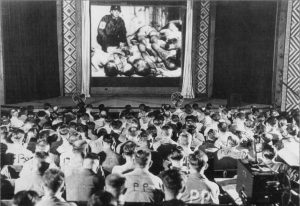 soldiers weren’t necessarily Nazis, and the Holocaust was just one side of the World War II. They were also fighting for territory and power. Strong nationalistic feelings were quite normal back then. Oddly, no conflict existed between not following the Nazis and fighting for the “good of your Fatherland.” Some soldiers were Nazis, some just wanted revenge for Versailles, others wanted to sit at the same table as France and Britain. And many followed because they had no other choice. It was a very strange situation, and one that had to be changed. It may not have been a humane way to bring change, but it was all they could do, so denazification was what they did…and at that time, it worked.
soldiers weren’t necessarily Nazis, and the Holocaust was just one side of the World War II. They were also fighting for territory and power. Strong nationalistic feelings were quite normal back then. Oddly, no conflict existed between not following the Nazis and fighting for the “good of your Fatherland.” Some soldiers were Nazis, some just wanted revenge for Versailles, others wanted to sit at the same table as France and Britain. And many followed because they had no other choice. It was a very strange situation, and one that had to be changed. It may not have been a humane way to bring change, but it was all they could do, so denazification was what they did…and at that time, it worked.
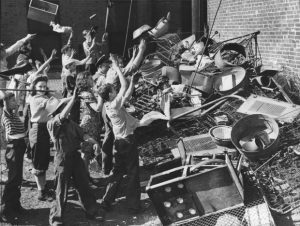 When the United States was pulled into World War II following the Japanese attack on Pearl Harbor. raw materials were in high demand globally, and hard to come by. Commodities such as rubber and cloth became precious and very valuable to the war effort. Many of the men were now off fighting the war, and so the factories, mines, etc. were not producing the necessary materials to build the much needed military equipment and weapons for the war effort.
When the United States was pulled into World War II following the Japanese attack on Pearl Harbor. raw materials were in high demand globally, and hard to come by. Commodities such as rubber and cloth became precious and very valuable to the war effort. Many of the men were now off fighting the war, and so the factories, mines, etc. were not producing the necessary materials to build the much needed military equipment and weapons for the war effort.
When it was decided that the country needed a drive to supply these materials, the Community-Minded Patriotism of the United States Home Front swung into action. The nation decided that they needed a drive to collect the materials needed. On Oct. 5, 1942, the first day of the first drive, young people throughout the city and county hauled in 2,800 tons of scrap metal to feed industry during World War II. By Oct. 16, the end of the campaign, their total was 7,658 tons, which is the combined weight of 230 Sherman tanks.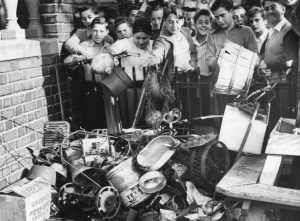
More scrap drives were organized across the country, encouraging citizens to contribute their rubber to make jeep tires, their clothing to make cleaning rags, their nylon and silk stockings to make parachutes, and their leftover cooking fat to make explosives. One of the most vital materials to collect was scrap metal. A single medium tank required 18 tons of it, and a single Navy ship hundreds more. For many people, I’m sure it looked like a great way to get rid of all those items most of us would try to unload at a garage sale.
The scrap metal drives became very competitive, almost frenzied affairs, as communities fought to out-contribute each other. Housewives threw in their aluminum pots and pans, farmers sacrificed their old tractors, and cities and towns ripped up wrought iron fences, trolley tracks and historic Civil War cannons. People were encouraged to imagine their household items being transformed into armor and weaponry for their soldiers and 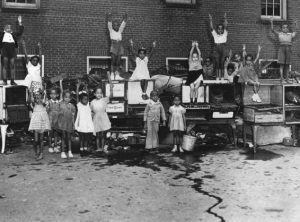 sailors in harm’s way. It was a great way to energize the Home Front. In Lubbock, Texas, a bust of Hitler was erected as a target for patriotic citizens to hurl their cookware. It was a way to take out their anger a little bit, and it worked. Walt Disney donated two iron Bambi sculptures, which were said to contain enough iron for 10,000 incendiary bombs or one 75 millimeter artillery piece. In all reality, the effect of these scrap metal drives on actual war production was very small, marginal at best. Nevertheless, their true value was in galvanizing citizen morale and a sense of patriotic unity…making everyone like they took part in the war effort. So, in the end, the scrap days did their job very well.
sailors in harm’s way. It was a great way to energize the Home Front. In Lubbock, Texas, a bust of Hitler was erected as a target for patriotic citizens to hurl their cookware. It was a way to take out their anger a little bit, and it worked. Walt Disney donated two iron Bambi sculptures, which were said to contain enough iron for 10,000 incendiary bombs or one 75 millimeter artillery piece. In all reality, the effect of these scrap metal drives on actual war production was very small, marginal at best. Nevertheless, their true value was in galvanizing citizen morale and a sense of patriotic unity…making everyone like they took part in the war effort. So, in the end, the scrap days did their job very well.
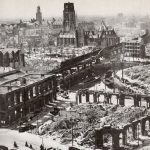 After World War II, most of Europe was in a big mess, whether it was the land,the cities and towns, or the government. There were scores of dead people around, countries and borders were torn apart, most of Europe had been “ground into a very civilized kind of pudding…and the USSR was knocking on the door to come and raid the fridge…so to speak.” Russia would have loved to sneak in and take over when they were at their most vulnerable. The people looked to the United States to figure out away to keep them safe, but not to occupy their countries, per se. That is a rather tall order, but one that the United States took seriously.
After World War II, most of Europe was in a big mess, whether it was the land,the cities and towns, or the government. There were scores of dead people around, countries and borders were torn apart, most of Europe had been “ground into a very civilized kind of pudding…and the USSR was knocking on the door to come and raid the fridge…so to speak.” Russia would have loved to sneak in and take over when they were at their most vulnerable. The people looked to the United States to figure out away to keep them safe, but not to occupy their countries, per se. That is a rather tall order, but one that the United States took seriously.
So the United States came up with Operation Gladio. Basically, they installed a secret military that would unofficially operate all across Europe. The secret military would have one and only one goal…combating communism. Little is known about this secret military, even today, because it wouldn’t be a very good secret army if we knew all about them. So, facts are pretty limited, but it’s not some crazy theory either. Their existence has been confirmed, and the network has been associated with such high-stakes super-evil events, as an attempted pope assassination, large scale bombings, and kidnappings of several high-level government officials. They were willing to do anything to fight communism…murder, extortion, even seemingly becoming communists, if that’s what it took. It turns out that the Italian branch was a particularly active group. An entirely different president of Italy, Francesco Cossiga, was involved in this ominous anti-communism secret society. The reason we don’t know more about them, even years after the end of the Cold War, is simple: crazy, crazy murders. Their secrets will follow them to the grave.
Then a new Italian president was elected. President Aldo Moro, wanted to allow communists to run for office.The still operating Gladio could not let this happen. He was suddenly kidnapped and eventually executed.  His body was found in the trunk of a car parked next to an ancient gladiatorial site. A warning to others…more than probably!! A “gladio” is an ancient Roman short sword, used in arena combat. A former colonel of Gladio operations in Switzerland decided to write a letter to the government stating that he was ready to “reveal the whole truth.” Again, Operation Gladio took action. The Gladio colonel was found dead in his home a month later. He was stabbed to death with his own bayonet. There were a series of mysterious characters written on his chest that couldn’t be deciphered. Of course, that’s not concrete evidence of Gladio’s direct involvement in these events, but these are just two brutal, worrying events that spin a web of mystery and fear that keeps further investigations from being opened. Sometimes, it’s best to let sleeping dogs lie.
His body was found in the trunk of a car parked next to an ancient gladiatorial site. A warning to others…more than probably!! A “gladio” is an ancient Roman short sword, used in arena combat. A former colonel of Gladio operations in Switzerland decided to write a letter to the government stating that he was ready to “reveal the whole truth.” Again, Operation Gladio took action. The Gladio colonel was found dead in his home a month later. He was stabbed to death with his own bayonet. There were a series of mysterious characters written on his chest that couldn’t be deciphered. Of course, that’s not concrete evidence of Gladio’s direct involvement in these events, but these are just two brutal, worrying events that spin a web of mystery and fear that keeps further investigations from being opened. Sometimes, it’s best to let sleeping dogs lie.
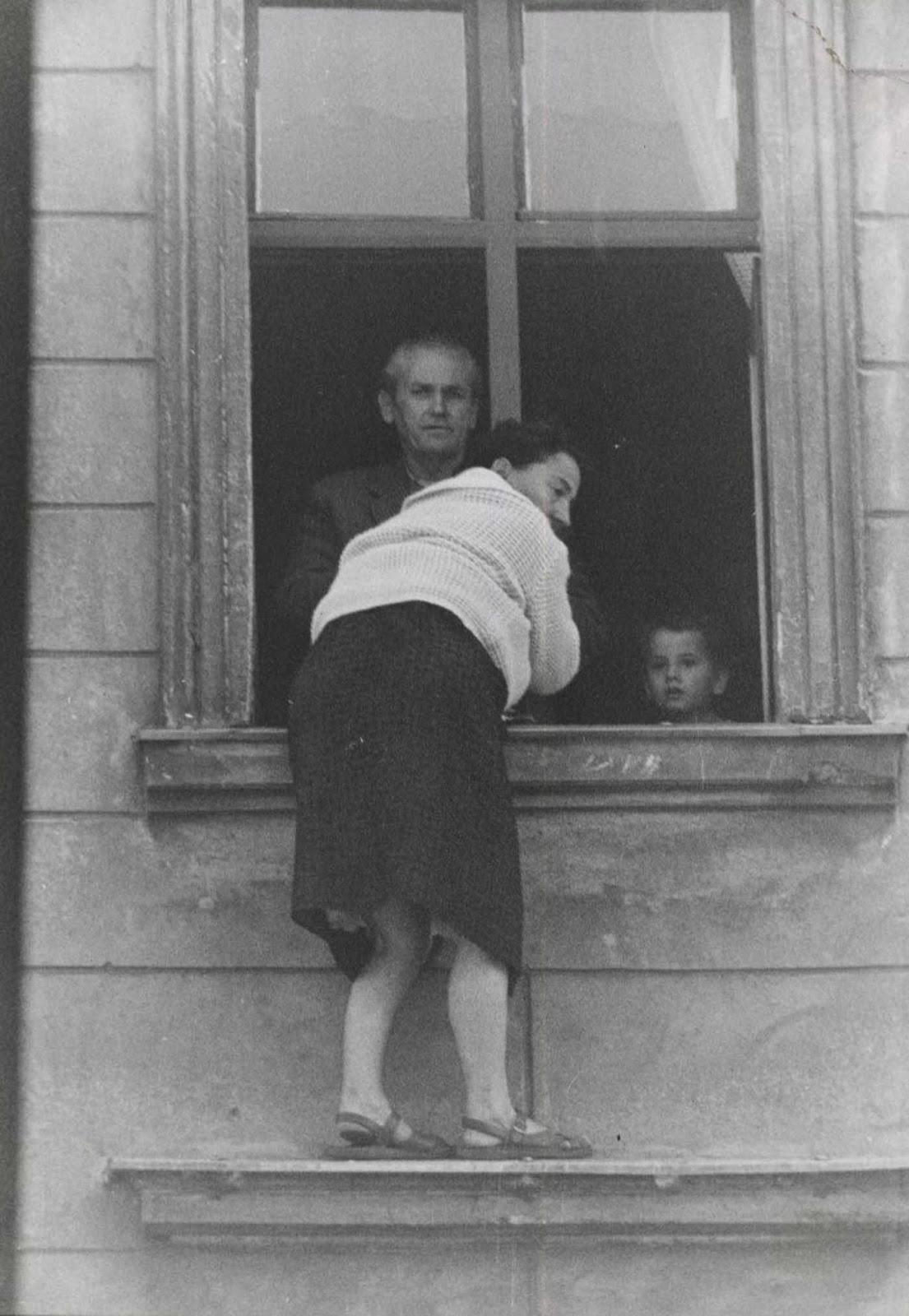 Imagine a world in which you could go to sleep living in freedom, and wake up behind prison walls…and you didn’t leave your home. That is exactly what happened to the people who lived in East Berlin. The Berlin Wall was erected overnight on August 13, 1961. The people of East Berlin were prisoners in their own city. Many of them had friends and family members who lived in West Berlin, but they were no longer allowed to go and see them, nor could the West Berliners come to East Berlin to see the inhabitants of that part of the city. The people in East Berlin were in a panic, and yet nothing could be done to free themselves from their plight. At least, not until they began to get very creative.
Imagine a world in which you could go to sleep living in freedom, and wake up behind prison walls…and you didn’t leave your home. That is exactly what happened to the people who lived in East Berlin. The Berlin Wall was erected overnight on August 13, 1961. The people of East Berlin were prisoners in their own city. Many of them had friends and family members who lived in West Berlin, but they were no longer allowed to go and see them, nor could the West Berliners come to East Berlin to see the inhabitants of that part of the city. The people in East Berlin were in a panic, and yet nothing could be done to free themselves from their plight. At least, not until they began to get very creative.
Many attempts were made in an effort to escape their captors, and many of those failed, but it would be the successful attempts at escape that would stay in our minds all these years. It was the successful attempts that were written about and celebrated in history, because those people won against a tyrannical government. One such escape was captured in pictures. Early in the construction, before most people even knew what was going on, Willy Finder figured it out and took steps to get his family out. His was a daring plan,but the people of West Berlin were willing to help pull it off. Willy’s wife was the first to go. I con only imagine how she must have felt. The plan required her to jump from the window ledge of their 4th story 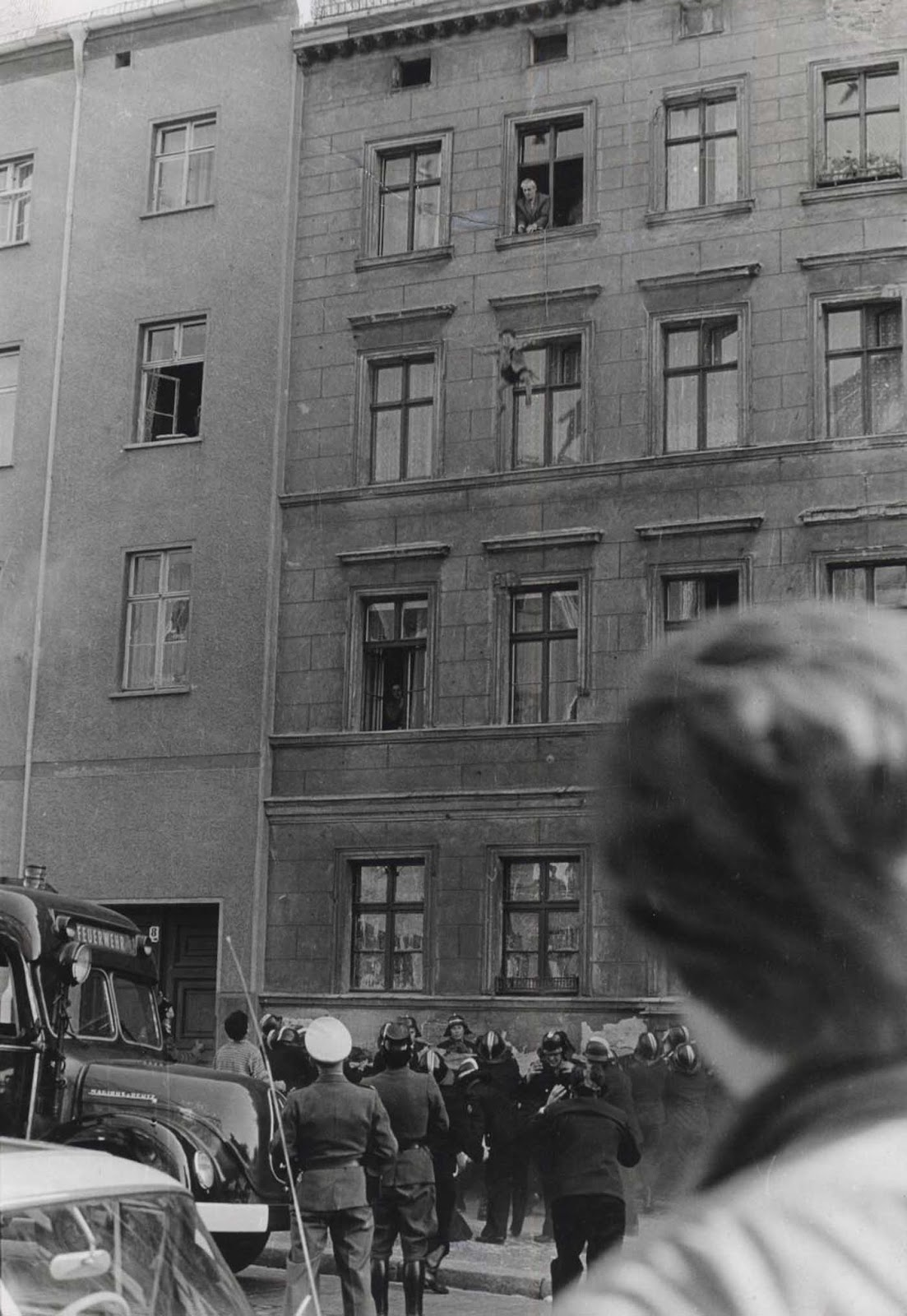 apartment, into a net held by residents and firemen in West Berlin. These apartments were along Bernauer Straße (street) in Berlin. The building actually saddled the border between East and West Berlin. After the wall was first constructed in 1961, many residents escaped through these apartment blocks, in this manner. So many, in fact, that the Soviets finally bricked up the windows and raided the apartments, evicting the people who lived there. After his mother jumped, four year old Michael Finder was tossed by his father to the waiting net below. There was no time to explain all this to his son…no time to reassure him. His daddy simply had to toss in out the window. Then Willy Finder made the jump himself. Theirs was a successful escape, one of many, and this infuriated the Soviet Union, because this was a part of the Soviet occupation zone formed after the reconstruction that followed World War II.
apartment, into a net held by residents and firemen in West Berlin. These apartments were along Bernauer Straße (street) in Berlin. The building actually saddled the border between East and West Berlin. After the wall was first constructed in 1961, many residents escaped through these apartment blocks, in this manner. So many, in fact, that the Soviets finally bricked up the windows and raided the apartments, evicting the people who lived there. After his mother jumped, four year old Michael Finder was tossed by his father to the waiting net below. There was no time to explain all this to his son…no time to reassure him. His daddy simply had to toss in out the window. Then Willy Finder made the jump himself. Theirs was a successful escape, one of many, and this infuriated the Soviet Union, because this was a part of the Soviet occupation zone formed after the reconstruction that followed World War II.
The Soviet occupation zone in Germany, and in Berlin, was suffering from numerous movements of educated individuals from their sectors toward the West throughout the 1950s. This movement, thought to be a brain drain, encouraged the Soviet Union to begin construction of a “Fascist Protection Wall” that was supposed to keep East Germans protected from “Fascism” that the Western Allies had “not eradicated in their sectors.” Of course, the reality was that the wall, later called the Berlin Wall, was designed to keep East Germans from emigrating to the West. The apartments 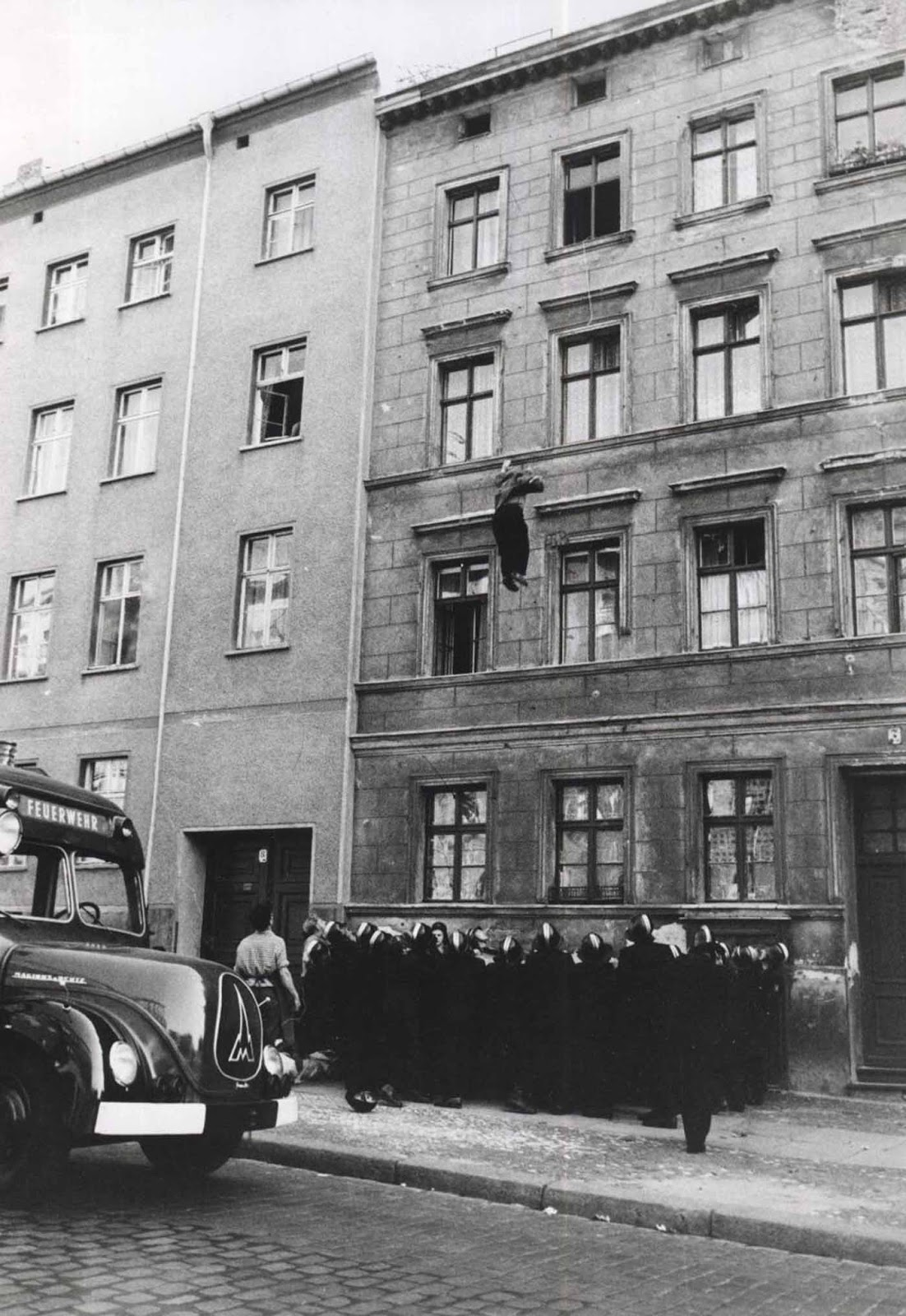 where the Finders lived were later torn down and the Berlin Wall that most of us picture in the news reels, and have chunks of in our museums all over the world, was erected. Nevertheless, between 1945 and 1988, around 4 million East Germans migrated to the West. The majority…as many as 3½ million people left between 1945 and the construction of the Berlin Wall in 1961. Of those, most simply walked across the border. After 1952, they exited through West Berlin. After the border was fortified and the Berlin Wall was constructed, the number of illegal border crossings fell drastically. The numbers fell further as border defenses were improved over the following decades. In 1961, 8,507 people fled across the border, most of them through West Berlin. The construction of the Berlin Wall that year reduced the number of escapees by 75% to around 2,300 per year for the rest of the decade. The Wall changed Berlin from being one of the easiest places to cross the border, from the East, to being one of the most difficult. The wall was finally torn down on June 13, 1990, and the German people were again free to move around the country.
where the Finders lived were later torn down and the Berlin Wall that most of us picture in the news reels, and have chunks of in our museums all over the world, was erected. Nevertheless, between 1945 and 1988, around 4 million East Germans migrated to the West. The majority…as many as 3½ million people left between 1945 and the construction of the Berlin Wall in 1961. Of those, most simply walked across the border. After 1952, they exited through West Berlin. After the border was fortified and the Berlin Wall was constructed, the number of illegal border crossings fell drastically. The numbers fell further as border defenses were improved over the following decades. In 1961, 8,507 people fled across the border, most of them through West Berlin. The construction of the Berlin Wall that year reduced the number of escapees by 75% to around 2,300 per year for the rest of the decade. The Wall changed Berlin from being one of the easiest places to cross the border, from the East, to being one of the most difficult. The wall was finally torn down on June 13, 1990, and the German people were again free to move around the country.
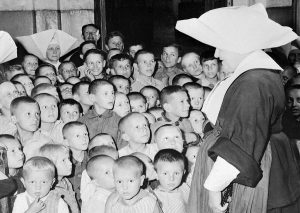 During the years of World War II, so much destruction brought with it the loss of jobs and homes. Along with the loss of jobs came poverty for many people. The smallest necessity became a “luxury” to people who had no problem making a living before. Many children were caught in the post-war poverty, because they lost their parents in the war. The orphanages were filled with children who were still in a daze, and trying to learn to be pretty much on their own, while still under the supervision of the state. I can only imagine how these little ones must have felt. Their parents were gone, they were grieving, and they were tossed into a strange building with many other children, all in the same boat. I’m sure the people running the orphanage did their best to comfort the children, but there were just so many of them.
During the years of World War II, so much destruction brought with it the loss of jobs and homes. Along with the loss of jobs came poverty for many people. The smallest necessity became a “luxury” to people who had no problem making a living before. Many children were caught in the post-war poverty, because they lost their parents in the war. The orphanages were filled with children who were still in a daze, and trying to learn to be pretty much on their own, while still under the supervision of the state. I can only imagine how these little ones must have felt. Their parents were gone, they were grieving, and they were tossed into a strange building with many other children, all in the same boat. I’m sure the people running the orphanage did their best to comfort the children, but there were just so many of them.
I’m sure that joy was stranger to most of the children. And I’m sure that the people who cared for them were looking for any way to put a smile on the faces of the children. Little did they know, how such a small thing as shoes, could change everything. They found out, when the Junior Red Cross in the United States of America put together boxes of what most of us would consider necessities to give to the children in Europe.
One six year old Austrian boy named Werfel, was photographed when he got a new pair of shoes at the Am Himmel orphanage, donated to him in the Christmastime care box. The picture taken of little Werfel, was enough to bring tears to the eyes of anyone who saw it. They may have been happy tears, but they were highly emotional tears nevertheless. Most kids these days, would be almost disappointed to receive a pair o shoes as  a gift…unless they were the latest in cool shoes. Little Werfel was beyond happy. He held the shoes to his chest and looked to the sky, as I he couldn’t possibly contain his happiness. The photographer probably took the picture through tear filled eyes. I know that’s what I would have done as the photographer. It was impossible not to be filled with emotion. “The photograph was first published in LIFE magazine on December 30, 1946 (on page 22) and later, again, on September 24, 1951 (on page 180). The photograph was shot by Gerald Waller, in 1946, and was titled “New Shoes”. The little boy, Werfel, was among the children who were brought to the USA after being deported from Israel / Palestine, where they arrived after liberation from the concentration camps. The image was published with the following caption in the 1946 issue. “EUROPE’S CHILDREN – Christmas brings joy and sadness.”
a gift…unless they were the latest in cool shoes. Little Werfel was beyond happy. He held the shoes to his chest and looked to the sky, as I he couldn’t possibly contain his happiness. The photographer probably took the picture through tear filled eyes. I know that’s what I would have done as the photographer. It was impossible not to be filled with emotion. “The photograph was first published in LIFE magazine on December 30, 1946 (on page 22) and later, again, on September 24, 1951 (on page 180). The photograph was shot by Gerald Waller, in 1946, and was titled “New Shoes”. The little boy, Werfel, was among the children who were brought to the USA after being deported from Israel / Palestine, where they arrived after liberation from the concentration camps. The image was published with the following caption in the 1946 issue. “EUROPE’S CHILDREN – Christmas brings joy and sadness.”
It was said that, “For many of Europe’s children there was a Santa Claus this Christmas. When a big box from the American Red Cross arrived at Vienna’s Am Himmel orphanage, shoes and coats and dresses tumbled out. Like the youngster (in the picture), the children who had seen no new clothes throughout the war smiled to high heaven. But for thousands of other European children there was no Santa Claus. When a boatload of illegal Jewish immigrants arrived at Haifa, Palestine recently, two Polish children (opposite) got separated from their parents. Tears filled the eyes of the boy, and his wan sister clutched him protectively. They were later reunited with their parents, but the whole family was shipped to Cyprus.”
The picture has stayed in my memory since the first time I saw it. To see that little boy so overjoyed…over shoes, was so beautiful. The photographer caught the picture perfectly. That moment was very likely one of the first truly happy moments that little boy had felt in quite some time. An adult, no matter the need would never 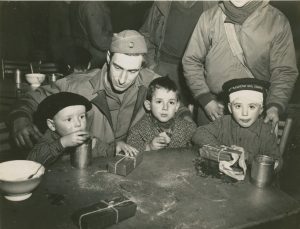 have shown such deep joy, probably because they would still be wrapped up in the poverty of the time, while the child was able to look beyond all that,and see the pure joy of the gift. The child could simply enjoy and cherish what has just been given to him, even though he was living in an orphanage…even though historical events had just unfolded,robbing him of his comfortable life…even though these were hand-me-downs. It made no difference to this boy, and it reminds us of how flawed our thinking is. We tend to look at the negatives in life and focus on them. Not this boy. He was happy with the tiniest positive thing that came into his life. It’s a lesson we should all learn. Sometimes we all need to appreciate the little things in life.
have shown such deep joy, probably because they would still be wrapped up in the poverty of the time, while the child was able to look beyond all that,and see the pure joy of the gift. The child could simply enjoy and cherish what has just been given to him, even though he was living in an orphanage…even though historical events had just unfolded,robbing him of his comfortable life…even though these were hand-me-downs. It made no difference to this boy, and it reminds us of how flawed our thinking is. We tend to look at the negatives in life and focus on them. Not this boy. He was happy with the tiniest positive thing that came into his life. It’s a lesson we should all learn. Sometimes we all need to appreciate the little things in life.
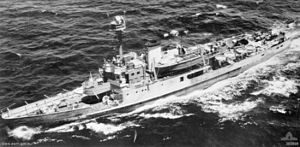 In the midst of World War II, February 1942, to be more exact, the Japanese fleet gave the combined Dutch-American-Australian-British fleet a beating that almost wiped them out completely, during the Battle of the Java Sea. The defeat brought about the Japanese occupation of the entire Netherlands East Indies. After the battle ended, only four Dutch warships were left in the Dutch East Indies. They knew there was no way they would be able to take down the Japanese fleet by themselves, so they decided to try to escape to Australia. The failed attempt left three of the four ships sunk, and one in hiding. The problem they had, was that the seas were full of warships and the skies were swarming with Japanese planes. It was going to be virtually impossible to sail the 1,000 miles of ocean to safety. The HNLMS Abraham Crijnssen, which was the last ship, had a big problem, for which they found a crazy solution.
In the midst of World War II, February 1942, to be more exact, the Japanese fleet gave the combined Dutch-American-Australian-British fleet a beating that almost wiped them out completely, during the Battle of the Java Sea. The defeat brought about the Japanese occupation of the entire Netherlands East Indies. After the battle ended, only four Dutch warships were left in the Dutch East Indies. They knew there was no way they would be able to take down the Japanese fleet by themselves, so they decided to try to escape to Australia. The failed attempt left three of the four ships sunk, and one in hiding. The problem they had, was that the seas were full of warships and the skies were swarming with Japanese planes. It was going to be virtually impossible to sail the 1,000 miles of ocean to safety. The HNLMS Abraham Crijnssen, which was the last ship, had a big problem, for which they found a crazy solution.
The HNLMS Abraham Crijnssen was a slow-moving minesweeper vessel that could get up to about 15 knots. It also had very few guns…a single 3-inch gun and two Oerlikon 20mm cannons…making it a sitting duck for the Japanese bombers that circled above. The secret weapon of the HNLMS Abraham Crijnssen, however, was it’s 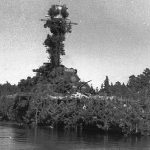 captain, who came up with a crazy scheme to disguise the ship as a small island. The Abraham Crijnssen was a relatively small ship, but it was still a big object, measuring approximately 180 feet long and 25 feet wide. The crew used foliage from island vegetation and gray paint to make the ship’s hull look like rock faces. They figured that it was better to be a camouflaged ship in deep trouble, than a completely exposed ship. Still, logic said that the Japanese would probably notice a mysterious moving island, and they might wonder what would happen if they shot at it. So,the plan came about that during the day, they would not move…thereby actually becoming an island.
captain, who came up with a crazy scheme to disguise the ship as a small island. The Abraham Crijnssen was a relatively small ship, but it was still a big object, measuring approximately 180 feet long and 25 feet wide. The crew used foliage from island vegetation and gray paint to make the ship’s hull look like rock faces. They figured that it was better to be a camouflaged ship in deep trouble, than a completely exposed ship. Still, logic said that the Japanese would probably notice a mysterious moving island, and they might wonder what would happen if they shot at it. So,the plan came about that during the day, they would not move…thereby actually becoming an island.
Moving only at night, the ship was able to blend in with the thousands of other tiny islands around Indonesia, and miraculously the Japanese didn’t notice the moving island. The Crijnssen managed to go undetected by Japanese planes and avoid the destroyer that sank the other Dutch warships, surviving the eight-day journey to Australia and reuniting with Allied forces, and fought with the Allies until the end of the war. During those years of service under the Australian Navy flag, Abraham Crijnssen detected a submarine, while escorting a convoy to Sydney through the Bass Strait, on 26th of January 1943. Along with the Australian HMAS Bundaberg, they depth charged the submarine. No wreckage of the submarine was found, nor was the kill  confirmed, but the ex-minesweeper Abraham Crijnssen suffered some damage due to hastily released depth charges. Several fittings and pipes were damaged, and all of her centerline had to be replaced during a week-long-dry docking. After this incident, the ship was returned to Royal Netherlands Navy service on May 5, 1943, spending the rest of the war in Australian waters. Abraham Crijnssen ended its WWII career just like the ship started it, as a minesweeper that was responsible for clearing mines in Kupang Harbor before the arrival of an RAN force to accept the Japanese surrender of Timor.
confirmed, but the ex-minesweeper Abraham Crijnssen suffered some damage due to hastily released depth charges. Several fittings and pipes were damaged, and all of her centerline had to be replaced during a week-long-dry docking. After this incident, the ship was returned to Royal Netherlands Navy service on May 5, 1943, spending the rest of the war in Australian waters. Abraham Crijnssen ended its WWII career just like the ship started it, as a minesweeper that was responsible for clearing mines in Kupang Harbor before the arrival of an RAN force to accept the Japanese surrender of Timor.
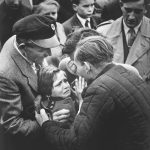 I think that over the years, we have all become used to men going off to war, and leaving their families safely at home, while they fight for the freedom and safety of people all over the world who are unknown to them. It’s a common part of war, and one that most of the time, the average person doesn’t even think about. It’s war after all, sacrifices have to be made. What we don’t always think about…until someone points out the obvious to us…is the families, and especially the children who are waiting for their parent to come home.
I think that over the years, we have all become used to men going off to war, and leaving their families safely at home, while they fight for the freedom and safety of people all over the world who are unknown to them. It’s a common part of war, and one that most of the time, the average person doesn’t even think about. It’s war after all, sacrifices have to be made. What we don’t always think about…until someone points out the obvious to us…is the families, and especially the children who are waiting for their parent to come home.
For any of us who have been away from family for an extended period of time, it’s easy to understand just how badly you can miss someone you love, but war is different. When your child moves away, you miss them, but you know you can go see them  soon. When you loved one goes off to war in a country where the fighting is heavy, and bombs are dropping everywhere…not only can you not go visit them whenever you want to, but you live with the knowledge that at any moment, they could be killed in action. And they are living with that knowledge too. It makes the time and distance seem much longer and much further than it really is.
soon. When you loved one goes off to war in a country where the fighting is heavy, and bombs are dropping everywhere…not only can you not go visit them whenever you want to, but you live with the knowledge that at any moment, they could be killed in action. And they are living with that knowledge too. It makes the time and distance seem much longer and much further than it really is.
While we might be able to fathom the pain of missing a family member, I think we find it even harder to grasp the complete and utter shocked sense of relief that these family members feel when they are reunited with their loved one again. The children are especially heart wrenching…or is it heart warming. It doesn’t really matter which it is,  because no one watching it does so without tears. It’s just impossible. When a German World War II prisoner, was released by the Soviet Union, and is reunited with his daughter, she cannot control her emotions. She had not seen her father since she was one year old, and she is about 5 years old. A mom who spent 7 months in Iraq, cannot contain herself when she sees her daughter again. An officer’s son breaks down because he wasn’t sure he would ever see his daddy again. These are the moments most of us never got to see, but now with the internet,we have the chance to look into the lives of those who serve our nation, fight our battles, and protect our world. It is in those moments that we realize what really happens when those who serve are reunited with their loved ones again.
because no one watching it does so without tears. It’s just impossible. When a German World War II prisoner, was released by the Soviet Union, and is reunited with his daughter, she cannot control her emotions. She had not seen her father since she was one year old, and she is about 5 years old. A mom who spent 7 months in Iraq, cannot contain herself when she sees her daughter again. An officer’s son breaks down because he wasn’t sure he would ever see his daddy again. These are the moments most of us never got to see, but now with the internet,we have the chance to look into the lives of those who serve our nation, fight our battles, and protect our world. It is in those moments that we realize what really happens when those who serve are reunited with their loved ones again.
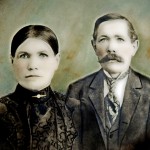 My great grandparents, Carl and Henriette (Hensel) Schumacher immigrated to the United States from Germany, in 1884 and 1882 respectively. It was an amazing time for them. The United States was a whole new world, and for those who came, the land of opportunity. By 1886, they were married and ready to start a family. My grandmother, Anna Schumacher was born in 1887, followed by siblings Albert, Mary (who died before she was 3), Mina, Fred, Bertha, and Elsa, who was born in 1902.
My great grandparents, Carl and Henriette (Hensel) Schumacher immigrated to the United States from Germany, in 1884 and 1882 respectively. It was an amazing time for them. The United States was a whole new world, and for those who came, the land of opportunity. By 1886, they were married and ready to start a family. My grandmother, Anna Schumacher was born in 1887, followed by siblings Albert, Mary (who died before she was 3), Mina, Fred, Bertha, and Elsa, who was born in 1902.
By 1914, World War I broke out, following the assassination of Franz Ferdinand. The government of the United States was understandably nervous about the German immigrants now living in in America. It didn’t matter that many of these people had been living in the united States for a long time, and some had become citizens, married, and had families. The government was still nervous, and I can understand how that could be, because we have the same problem these days with the Muslim nations. Still, when I think about the fact that these were my sweet, kind, and loving, totally Lutheran great grandparents, I find it hard to believe that anyone could be nervous about them. Apparently, I was right, because to my knowledge, they were never detained in any of the internment camps, nor were they even threatened with it.
Nevertheless, there were German nationals, and even naturalized citizens who faced possible detention during 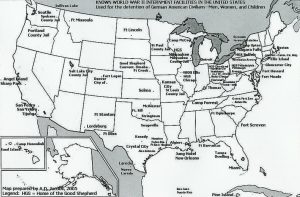 World War I and World War II. By World War II, President Franklin Delano Roosevelt declared Presidential Proclamation 2526, the legal basis for internment under the authority of the Alien and Sedition Acts. With the United States’ entry into World War I, the German nationals were automatically classified as “enemy aliens.” Two of the four main World War I-era internment camps were located in Hot Springs, North Carolina and Fort Oglethorpe, Georgia. Attorney General A. Mitchell Palmer wrote that “All aliens interned by the government are regarded as enemies, and their property is treated accordingly.”
World War I and World War II. By World War II, President Franklin Delano Roosevelt declared Presidential Proclamation 2526, the legal basis for internment under the authority of the Alien and Sedition Acts. With the United States’ entry into World War I, the German nationals were automatically classified as “enemy aliens.” Two of the four main World War I-era internment camps were located in Hot Springs, North Carolina and Fort Oglethorpe, Georgia. Attorney General A. Mitchell Palmer wrote that “All aliens interned by the government are regarded as enemies, and their property is treated accordingly.”
By the time of World War II, the United States had a large population of ethnic Germans. Among residents of the United States in 1940, more than 1.2 million persons had been born in Germany, 5 million had two native-German parents, and 6 million had one native-German parent. Many more had distant German ancestry. With that many people of German ancestry, it seems impossible that they could have detained all of them. Nevertheless, at least 11,000 ethnic Germans, overwhelmingly German nationals were detained during World War II in the United States. The government examined the cases of German nationals individually, and detained relatively few in internment camps run by the Department of Justice, as per its responsibilities under the Alien and Sedition Acts. To a much lesser extent, some ethnic German United States citizens were classified as suspect after due process and also detained. There were also a small proportion of Italian nationals 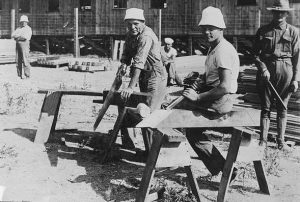 and Italian Americans who were interned in relation to their total population in the United States. The United States had allowed immigrants from both Germany and Italy to become naturalized citizens, which many had done by then. It was much less likely for those people to be detained, if they had already become citizens. In the early 21st century, Congress considered legislation to study treatment of European Americans during World War II, but it did not pass the House of Representatives. Activists and historians have identified certain injustices against these groups. I suppose that some injustices were done, but those were times of war and strong measures were needed.
and Italian Americans who were interned in relation to their total population in the United States. The United States had allowed immigrants from both Germany and Italy to become naturalized citizens, which many had done by then. It was much less likely for those people to be detained, if they had already become citizens. In the early 21st century, Congress considered legislation to study treatment of European Americans during World War II, but it did not pass the House of Representatives. Activists and historians have identified certain injustices against these groups. I suppose that some injustices were done, but those were times of war and strong measures were needed.
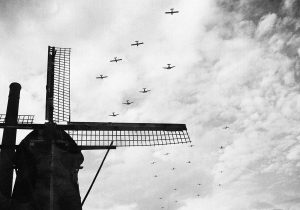 It has been 74 years since 17,740 Americans gave their lives to liberate the people of the Netherlands (often called Holland) from the Germans during World War II, and the people of Holland have never forgotten that sacrifice. For 74 years now, the people of the small village of Margraten, Netherlands have taken care of the graves of the lost at the Margraten American Cemetery. On Memorial Day, they come, every year, bringing Memorial Day bouquets for men and women they never knew, but whose 8,300 headstones the people of the Netherlands have adopted as their own. Of the 17,740 who were originally buried there, 9,440 were later moved to various paces in he United States by their families. “What would cause a nation recovering from losses and trauma of their own to adopt the sons and daughters of another nation?” asked Chotin, the only American descendant to speak on that Sunday 4 years ago. “And what would keep that commitment alive for all of these years, when the memory of that war has begun to fade? It is a unique occurrence in the history of civilization.”
It has been 74 years since 17,740 Americans gave their lives to liberate the people of the Netherlands (often called Holland) from the Germans during World War II, and the people of Holland have never forgotten that sacrifice. For 74 years now, the people of the small village of Margraten, Netherlands have taken care of the graves of the lost at the Margraten American Cemetery. On Memorial Day, they come, every year, bringing Memorial Day bouquets for men and women they never knew, but whose 8,300 headstones the people of the Netherlands have adopted as their own. Of the 17,740 who were originally buried there, 9,440 were later moved to various paces in he United States by their families. “What would cause a nation recovering from losses and trauma of their own to adopt the sons and daughters of another nation?” asked Chotin, the only American descendant to speak on that Sunday 4 years ago. “And what would keep that commitment alive for all of these years, when the memory of that war has begun to fade? It is a unique occurrence in the history of civilization.”
The people of Margraten immediately embraced the Americans, who had come to their aid when they needed it most. The town’s mayor invited the company’s commanders to sleep in his home, while the enlisted men slept in the schools. The protection against rain and buzz bombs was welcomed. Later, villagers hosted U.S. troops when the men were given rest-and-recuperation breaks from trying to breach the German frontier defenses, known as the Siegfried Line. “After four dark years of occupation, suddenly [the Dutch] people were free from the Nazis, and they could go back to their normal lives and enjoy all the freedoms they were used to. They knew they had to thank the American allies for that,” explained Frenk Lahaye, an associate at the cemetery.
By November 1944, two months after the village’s 1,500 residents had been freed from Nazi occupation by the U.S. 30th Infantry Division the town’s people were filled with gratitude, but the war wasn’t over. In late 1944 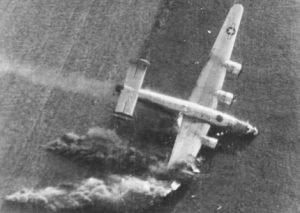 and early 1945, thousands of American soldiers would be killed in nearby battles trying to pierce the German defense lines. The area was filled with Booby-traps and heavy artillery fire. All that combined with a ferocious winter, dealt major setbacks to the Allies, who had already suffered losses trying to capture strategic Dutch bridges crossing into Germany during the ill-fated Operation Market Garden.
and early 1945, thousands of American soldiers would be killed in nearby battles trying to pierce the German defense lines. The area was filled with Booby-traps and heavy artillery fire. All that combined with a ferocious winter, dealt major setbacks to the Allies, who had already suffered losses trying to capture strategic Dutch bridges crossing into Germany during the ill-fated Operation Market Garden.
Now, the U.S. military needed a place to bury its fallen. The Americans ultimately picked a fruit orchard just outside Margraten. On the first day of digging, the sight of so many bodies made the men in the 611th Quartermaster Graves Registration Company ill. The bodies arrived in a procession of trucks and trailers. Death hung in the air over the whole village of Margraten. The sight of so much death caused a few of the people helping with the burials to become ill. They suddenly made a break for the latrines. The first burial at Margraten took place on November 10, 1944. Laid to rest in Plot A, Row 1, Grave 1: John David Singer Jr, a 25-year-old infantryman, whose remains would later be repatriated and buried in Denton, Maryland, about 72 miles east of Washington. Between late 1944 and spring 1945, up to 500 bodies arrived each day, so many that the mayor went door to door asking villagers for help with the digging. Over the next two years, about 17,740 American soldiers would be buried here, though the number of graves would shrink as thousands of families asked for their loved ones’ remains to be sent home, until 8,300 remained, and still, the graves are cared for by the town’s people, as if the dead were their own loved one. Not only that, but they have taken it upon themselves to research the deceased, and learn of their lives as a way of showing honor to these fallen heroes.
On May 29, 1945, the day before the cemetery’s first Memorial Day commemoration, 20 trucks from the 611th  collected flowers from 60 different Dutch villages. Nearly 200 Dutch men, women and children spent all night arranging flowers and wreaths by the dirt-covered graves, which bore makeshift wooden crosses and Stars of David. By 8am, the road leading into Margraten was jammed with Dutch people coming on foot, bicycle, carriages, horseback and by car. Silent film footage shot that day shows some of the men wearing top hats as they carried wreaths. A nun and two young girls laid flowers at a grave, then prayed. Solemn-faced children watched as cannons blasted salutes. The Dutch, Shomon wrote, “were perceptibly stirred, wept in bowed reverence.” All they do for these heroes is because they have vowed never to forget.
collected flowers from 60 different Dutch villages. Nearly 200 Dutch men, women and children spent all night arranging flowers and wreaths by the dirt-covered graves, which bore makeshift wooden crosses and Stars of David. By 8am, the road leading into Margraten was jammed with Dutch people coming on foot, bicycle, carriages, horseback and by car. Silent film footage shot that day shows some of the men wearing top hats as they carried wreaths. A nun and two young girls laid flowers at a grave, then prayed. Solemn-faced children watched as cannons blasted salutes. The Dutch, Shomon wrote, “were perceptibly stirred, wept in bowed reverence.” All they do for these heroes is because they have vowed never to forget.
 During World War II, it seems that there were a number of missed warnings about coming actions. Perhaps, if these warnings had been heeded, parts of the war, and indeed the length of it might have been different. One such event occurred when two German officers who were flying after consuming too much alcohol, became lost in the inky black night sky, when suddenly their plane began to nosedive. Maybe they thought, as their doomed plane plunged toward the ground, “Please let this be German soil we’re hurtling towards.” No matter what their thoughts were, they were definitely not headed for a crash landing in Germany, but rather they crashed in Holland.
During World War II, it seems that there were a number of missed warnings about coming actions. Perhaps, if these warnings had been heeded, parts of the war, and indeed the length of it might have been different. One such event occurred when two German officers who were flying after consuming too much alcohol, became lost in the inky black night sky, when suddenly their plane began to nosedive. Maybe they thought, as their doomed plane plunged toward the ground, “Please let this be German soil we’re hurtling towards.” No matter what their thoughts were, they were definitely not headed for a crash landing in Germany, but rather they crashed in Holland.
The crash landing in Holland was a big problem for the officers, because they were carrying battle plans for Hitler’s coming invasion of Holland. The plans, which involved exotic strategies like flamethrowers, and using gliders to silently deliver troops behind enemy lines, all seemed so unlikely that the  Dutch commanders refused to believe it. Just weeks later, it all unfolded exactly as the plan had foretold. Germany occupied Holland. It seems incredible but almost every daring German offensive was known well beforehand. Yet, in every case, those in power refused to see what was right in front of them. Hitler could have been stopped long before he was, if these botched early warnings had been taken seriously. In another such example, a German deserter was captured by the Russians. He gave up the plans to Hitler’s “Operation Barbarossa.” Yet, the Russian commanders found the 1,800 mile wide offensive too unlikely to believe. Then, just weeks later, they were caught off guard by the largest invasion in history.
Dutch commanders refused to believe it. Just weeks later, it all unfolded exactly as the plan had foretold. Germany occupied Holland. It seems incredible but almost every daring German offensive was known well beforehand. Yet, in every case, those in power refused to see what was right in front of them. Hitler could have been stopped long before he was, if these botched early warnings had been taken seriously. In another such example, a German deserter was captured by the Russians. He gave up the plans to Hitler’s “Operation Barbarossa.” Yet, the Russian commanders found the 1,800 mile wide offensive too unlikely to believe. Then, just weeks later, they were caught off guard by the largest invasion in history.
But, perhaps the most chilling warning of all came far earlier: before the war had even started. The warning came from an analyst dispatched to Hitler’s Germany in 1938. In 1939 he delivered a sobering prediction: the worst conflict in history was about to begin. He reported: “War is coming to Europe, but not until September at the earliest.” On September 1, 1939, Hitler launched his attack on Poland. World 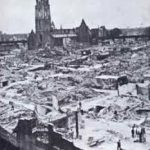 War II had begun. That analyst belonged to a group that soon became part of the largest underground news and research network in the world. One that would go on to predict large world shifts with shocking accuracy: As early as 1987, this network predicted the fall of the Soviet Union. In 1989, they called the crash of the Japanese “miracle.” In the early 90s, they spoke out about the threat of radical Islamic terrorism. In the mid 2000s, they predicted the 2008 financial meltdown. They also predicted Donald Trump’s improbable win in the 2016 Presidential race, which in my opinion was their best prediction. Sadly, this underground news and research group, was not taken seriously in the warnings they gave, and the world paid the consequences for those missed warnings.
War II had begun. That analyst belonged to a group that soon became part of the largest underground news and research network in the world. One that would go on to predict large world shifts with shocking accuracy: As early as 1987, this network predicted the fall of the Soviet Union. In 1989, they called the crash of the Japanese “miracle.” In the early 90s, they spoke out about the threat of radical Islamic terrorism. In the mid 2000s, they predicted the 2008 financial meltdown. They also predicted Donald Trump’s improbable win in the 2016 Presidential race, which in my opinion was their best prediction. Sadly, this underground news and research group, was not taken seriously in the warnings they gave, and the world paid the consequences for those missed warnings.

